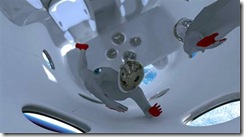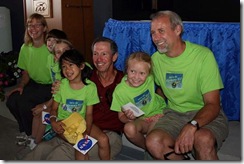Posted: Wednesday, July 30, 2008 by Alan Boyle
Virgin Galactic
An artist's conception shows passengers in the SpaceShipTwo rocket plane.
Millions could afford to take such flights by 2020, the craft's designer says.
Leaders of the "Old Space" effort and the "New Space" effort laid out separate visions for the next 15 years on the final frontier at the world's biggest experimental air show this week. It turns out that their visions are not all that separate - and that the current space frontiers are not anywhere near that final.
The bottom line? If you think space is cool now, just wait.
By the year 2020, about 100,000 people will have taken a suborbital ride into outer space, said Burt Rutan, the designer of the SpaceShipOne and SpaceShipTwo rocket planes. He said such a trip will be within the reach of millions more, at a cost substantially less than the current going rate of $200,000 - and tourists should be able to buy trips into orbit and around the moon as well.
"All the fun stuff, I think, will be available to the public sooner, because we took the time right now to develop a high-use, affordable, fly-a-lot-of-people space system," Rutan told an overflow crowd Tuesday night at the EAA AirVenture air show in Oshkosh, Wis.
Meanwhile, NASA will be setting up permanent bases on the moon by 2023, and laying out plans for getting to Mars by 2033, Mike Griffin, the space agency's administrator, told a different AirVenture gathering.
Neither of those visions are set in stone, of course: For Rutan and his fellow private-sector rocketeers, it all depends on proving that space tourism is a viable business. Despite the occasional encouraging market study, that proposition still has to be proven in the real world. Virgin Galactic's SpaceShipTwo is still more than a year away from starting commercial service, although a significant step forward was taken this week with the rollout of the rocket plane's mothership.
For Griffin, the predictions about the moon and Mars depend on politicians maintaining the current level of funding for NASA - and "not jerking us around" on space policy.
"It is within our capacity to do it," he said. "It is within our budget capacity to do it, if it remains within our will to do it."
The 'why' of space travel
So why do it? In Oshkosh, leading lights of "Old Space" and "New Space" both cited physicist Stephen Hawking's recent comment about the necessity of space travel. Hawking said spreading out into the cosmos would be the only way to guarantee against the effect of a planetwide catastrophe - and that view got an "amen" from Will Whitehorn, president of Virgin Galactic, as well as from Griffin.
"In the long run, space exploration is about the survival of our human species," Griffin said.
Kathy Barnstorff / NASA
NASA Administrator Mike Griffin, at center in the dark red shirt, has his picture
taken Tuesday with girls from the World Group Home School in Monona, Wis., who
helped name one of the international space station's modules "Harmony."
Whitehorn went even further, arguing that without the benefits of the past 50 years of satellite sensing, Earth would be in a world of hurt today. He pointed out that satellite monitoring has given a big boost to global agricultural production - and said "we'd literally have half a billion people starving right now" if those space assets didn't exist.
"What people don't understand is that space is absolutely crucial to our survival right now," he said.
Old vs. New? The line gets fuzzier
Going forward, it won't be so easy to separate "New Space" from "Old Space." Sure, Virgin Galactic is counting on the revenue from space tourism. "You are the large-volume payload that's been missing," Rutan told Tuesday's appreciative audience.
But Rutan and other New Spacers are hoping NASA will buy some rides as well. That's what Griffin hopes, too: "I've said repeatedly that when commercial human spaceflight opportunities exist, NASA will be a purchaser of those services, whether for astronaut training or for scientific flights," he said.
NASA is in the market for orbital services as well: Two companies, SpaceX and Orbital Sciences, are getting millions of dollars in development funds to build spaceships capable of resupplying the international space station once the shuttle fleet retires in 2010. Griffin said the space agency's recent request for station resupply bids drew proposals from more than a dozen companies.
"I'm very confident that we're going to find some [orbital space services] that we're going to want to purchase," he said.
Pushing out the frontier
Griffin is fond of saying that NASA is involved in the same sort of exploration that sailors on Viking ships or clipper ships took on centuries ago - and is facing the same sorts of challenges. (For example, just as the British voyagers figured out how to beat scurvy, voyagers to Mars are going to have to figure out how to beat deep-space radiation.)
If you extend that metaphor, you'll find that settlers and salesmen almost always followed in the footsteps of the explorers. Rutan slyly referred to that phenomenon during one of his talks in Oshkosh, when he looked right at Virgin Galactic's rebel billionaire, Richard Branson, and observed that innovators "tend to look like a swashbuckler."
If the visions voiced by Rutan and Griffin come true, the explorers will have pushed far beyond Earth orbit by 2023 - leaving plenty of open space for sightseers and settlers. And maybe swashbucklers as well.
Bits and pieces
Tuesday's sessions were mostly devoted to questions and answers, and here are some of the miscellaneous nuggets that came out of the give-and-take:
- White Knight Two, the plane that will carry SpaceShipTwo up to 50,000 feet for an air launch, has extra seats for ride-alongs, and Rutan said those riders could get an experience much like a spaceflight - complete with a zero-G float, followed by a jolt of acceleration that could briefly go as high as 6 G's. That could serve as a shakedown cruise for would-be spacefliers. Still more seats could eventually be put in White Knight Two's left-side cabin, and Whitehorn said "we would hope that the tickets for that side of the hull would be $900 to $1,000 at the most."
- Whitehorn promised that the White Knight Two / SpaceShipTwo would be flown to Oshkosh next year if at all possible. That would be an on-the-ground display opportunity, with SpaceShipTwo remaining firmly attached to its mothership. But Oshkosh also might get first crack if and when Virgin Galactic takes its launch operation on the road. "The first place we'll bring it, commercially, is going to be Oshkosh," Whitehorn said, sparking applause from AirVenture attendees.
- NASA's Griffin acknowledged that he wasn't happy about the five-year gap between the shuttle fleet's retirement in 2010 and the planned debut of the Orion-Ares launch system in 2015. That gap means NASA will have to purchase rides to the space station from other countries or private providers. But Griffin said the agency couldn't afford to keep the shuttles in operation while it was developing their successors, based on Congress' current funding formula. "I admit, on the face of it, that seems silly," he told the crowd. "But ... I don't want to shock anybody, sometimes in Washington we do think of silly things."
- Griffin downplayed media reports about vibration problems with the Ares 1 rocket, saying that there were "half a dozen means to mitigate that" and that two top strategies would be selected for further study next month. "Let me put it this way: I hope this is the worst problem we have in developing a new system," he said.
- He said NASA was working out a deal to send a small, experimental VASIMR engine to the space station for testing. Boosters of the VASIMR plasma technology say such engines could be used on spacecraft bound for Mars and beyond.
- Griffin said "NASA can technically fly" a shuttle mission to deliver the $1.5 billion Alpha Magnetic Spectrometer to the space station, but he noted that no money has yet been appropriated for such a flight. Until the funding is provided, "AMS won't fly, because it can't fly for free," he said.


No comments:
Post a Comment